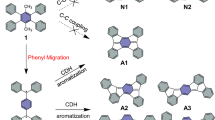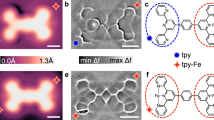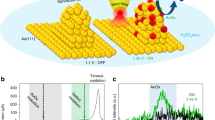Abstract
Understanding the mechanism of catalytic hydrogenation at the local environment requires chemical and topographic information involving catalytic sites, active hydrogen species, and their spatial distribution. Here we used tip-enhanced Raman spectroscopy (TERS) to study the catalytic hydrogenation of chloronitrobenzenethiol on a well-defined Pd(submonolayer)/Au(111) bimetallic catalyst (\(p_{\rm{H}_{2}}\) = 1.5 bar, 298 K), where the surface topography and chemical fingerprint information were simultaneously mapped with nanoscale resolution (~10 nm). TERS imaging of the surface after catalytic hydrogenation confirms that the reaction occurs beyond the location of Pd sites. The results demonstrate that hydrogen spillover accelerates hydrogenation at Au sites as far as 20 nm from the bimetallic Pd/Au boundary. Density functional theory was used to elucidate the thermodynamics of interfacial hydrogen transfers. We demonstrate TERS to be a powerful analytical tool that provides a unique approach to spatially investigate the local structure–reactivity relationship in catalysis.

This is a preview of subscription content, access via your institution
Access options
Access Nature and 54 other Nature Portfolio journals
Get Nature+, our best-value online-access subscription
$29.99 / 30 days
cancel any time
Subscribe to this journal
Receive 12 digital issues and online access to articles
$119.00 per year
only $9.92 per issue
Buy this article
- Purchase on Springer Link
- Instant access to full article PDF
Prices may be subject to local taxes which are calculated during checkout






Similar content being viewed by others
Data availability
The original data used in this publication are made available in a curated data archive at ETH Zurich (https://www.researchcollection.ethz.ch) under https://doi.org/10.3929/ethz-b-000423837, or are available from the corresponding authors upon reasonable request. Source data are provided with this paper.
Code availability
The MATLAB codes used for processing the data are made available in a curated data archive at ETH Zurich (https://www.researchcollection.ethz.ch) under https://doi.org/10.3929/ethz-b-000423837, or are available from the corresponding authors upon reasonable request.
References
Buurmans, I. L. C. & Weckhuysen, B. M. Heterogeneities of individual catalyst particles in space and time as monitored by spectroscopy. Nat. Chem. 4, 873–886 (2012).
Sambur, J. B. et al. Sub-particle reaction and photocurrent mapping to optimize catalyst-modified photoanodes. Nature 530, 77–80 (2016).
Agarwal, N. et al. Aqueous Au–Pd colloids catalyze selective CH4 oxidation to CH3OH with O2 under mild conditions. Science 358, 223–227 (2017).
Cárdenas-Lizana, F. et al. Pd-promoted selective gas phase hydrogenation of p-chloronitrobenzene over alumina supported Au. J. Catal. 262, 235–243 (2009).
Lucci, F. R. et al. Controlling hydrogen activation, spillover, and desorption with Pd−Au single-atom alloys. J. Phys. Chem. Lett. 7, 480–485 (2016).
Marcinkowski, M. et al. Controlling a spillover pathway with the molecular cork effect. Nat. Mater. 12, 523–528 (2013).
Huizinga, T. & Prins, R. Behavior of titanium (3+) centers in the low- and high-temperature reduction of platinum/titanium dioxide, studied by ESR. J. Phys. Chem. 85, 2156–2158 (1981).
Briggs, N. M. et al. Identification of active sites on supported metal catalysts with carbon nanotube hydrogen highways. Nat. Commun. 9, 3827 (2018).
Kyriakou, G. et al. Isolated metal atom geometries as a strategy for selective heterogeneous hydrogenations. Science 335, 1209–1212 (2012).
Miller, J. T. et al. Hydrogen temperature-programmed desorption (H2 TPD) of supported platinum catalysts. J. Catal. 143, 395–408 (1993).
Karim, W. et al. Catalyst support effects on hydrogen spillover. Nature 541, 68–71 (2017).
van Lent, R. et al. Site-specific reactivity of molecules with surface defects—the case of H2 dissociation on Pt. Science 363, 155–157 (2019).
Dong, J. et al. In situ Raman spectroscopic evidence for oxygen reduction reaction intermediates at platinum single-crystal surfaces. Nat. Energy 4, 60–67 (2019).
Zhong, J. et al. Probing the electronic and catalytic properties of a bimetallic surface with 3 nm resolution. Nat. Nanotechnol. 12, 132–136 (2017).
Zhang, R. et al. Chemical mapping of a single molecule by plasmon-enhanced Raman scattering. Nature 498, 82–86 (2013).
Lee, J., Crampton, K. T., Tallarida, N. & Apkarian, V. A. Visualizing vibrational normal modes of a single molecule with atomically confined light. Nature 568, 78–82 (2019).
van Schrojenstein Lantman, E. M., Deckert-Gaudig, T., Mank, A. J. G., Deckert, V. & Weckhuysen, B. M. Catalytic processes monitored at the nanoscale with tip-enhanced Raman spectroscopy. Nat. Nanotechnol. 7, 583–586 (2012).
Herrero, E., Buller, L. J. & Abruña, H. D. Underpotential deposition at single crystal surfaces of Au, Pt, Ag and other materials. Chem. Rev. 101, 1897–1930 (2001).
Lin, L. et al. A highly CO-tolerant atomically dispersed Pt catalyst for chemoselective hydrogenation. Nat. Nanotechnol. 14, 354–361 (2019).
Pan, M. et al. Model studies of heterogeneous catalytic hydrogenation reactions with gold. Chem. Soc. Rev. 42, 5002–5013 (2013).
Kibler, L. A., Kleinert, M., Randler, R. & Kolb, D. M. Initial stages of Pd deposition on Au (hkl). Part I: Pd on Au (111). Surf. Sci. 443, 19–30 (1999).
Chen, C., Hayazawa, N. & Kawata, S. A 1.7 nm resolution chemical analysis of carbon nanotubes by tip-enhanced Raman imaging in the ambient. Nat. Commun. 5, 3312 (2014).
Su, H. et al. Probing the local generation and diffusion of active oxygen species on a Pd/Au bimetallic surface by tip-enhanced Raman spectroscopy. J. Am. Chem. Soc. 142, 1341–1347 (2020).
Lopez, N., Łodziana, Z., Illas, F. & Salmeron, M. When Langmuir is too simple: H2 dissociation on Pd(111) at high coverage. Phys. Rev. Lett. 93, 146103 (2004).
Groß, A. & Dianat, A. Hydrogen dissociation dynamics on precovered Pd surfaces: Langmuir is still right. Phys. Rev. Lett. 98, 206107 (2007).
Lauhon, L. J. & Ho, W. Direct observation of the quantum tunneling of single hydrogen atoms with a scanning tunneling microscope. Phys. Rev. Lett. 89, 079901 (2002).
Marshall, S. et al. Controlled selectivity for palladium catalysts using self-assembled monolayers. Nat. Mater. 9, 853–858 (2010).
Abazari, R., Heshmatpour, F. & Balalaie, S. Pt/Pd/Fe trimetallic nanoparticle produced via reverse micelle technique: synthesis, characterization, and its use as an efficient catalyst for reductive hydrodehalogenation of aryl and aliphatic halides under mild conditions. ACS Catal. 3, 139–149 (2013).
de Pedro, Z. M., Casas, J. A., Gomez-Sainero, L. M. & Rodriguez, J. J. Hydrodechlorination of dichloromethane with a Pd/AC catalyst: reaction pathway and kinetics. Appl. Catal. B 98, 79–85 (2010).
Qian, X., Emory, S. R. & Nie, S. Anchoring molecular chromophores to colloidal gold nanocrystals: surface-enhanced Raman evidence for strong electronic coupling and irreversible structural locking. J. Am. Chem. Soc. 134, 2000–2003 (2012).
Coq, B., Ferrat, G. & Figueras, F. Conversion of chlorobenzene over palladium and rhodium catalysts of widely varying dispersion. J. Catal. 101, 434–445 (1986).
Stadler, J., Schmid, T. & Zenobi, R. Nanoscale chemical imaging using top-illumination tip-enhanced Raman spectroscopy. Nano Lett. 10, 4514–4520 (2010).
Clavilier, J., Faure, R., Guinet, G. & Durand, R. Preparation of monocrystalline Pt microelectrodes and electrochemical study of the plane surfaces cut in the direction of the {111} and {110} planes. J. Electroanal. Chem. 107, 205–209 (1979).
Weiss, E. A. et al. Si/SiO2-templated formation of ultrafast metal surfaces on glass, polymer, and solder supports: their use as substrates for self-assembled monolayers. Langmuir 23, 9686–9694 (2007).
Zhang, Y.-J. et al. Probing the electronic structure of heterogeneous metal interfaces by transition metal shelled gold nanoparticle-enhanced Raman spectroscopy. J. Phys. Chem. C. 120, 20684–20691 (2016).
Gyr, L., Klute, F. D., Franzke, J. & Zenobi, R. Characterization of a nitrogen-based dielectric barrier discharge ionization source for mass spectrometry reveals factors important for soft ionization. Anal. Chem. 91, 6865–6871 (2019).
Szczerbiński, J., Gyr, L., Kaeslin, J. & Zenobi, R. Plasmon-driven photocatalysis leads to products known from E-beam and X-ray-induced surface chemistry. Nano Lett. 18, 6740–6749 (2018).
Kresse, G. & Furthmüller, J. Efficient iterative schemes for ab initio total-energy calculations using a plane-wave basis set. Phys. Rev. B 54, 11169 (1996).
Klimeš, J., Bowler, D. R. & Michaelides, A. Chemical accuracy for the van der Waals density functional. J. Phys. Condens. Matter 22, 022201 (2010).
Carrasco, J., Klimeš, J. & Michaelides, A. The role of van der Waals forces in water adsorption on metals. J. Chem. Phys. 138, 024708 (2013).
Berland, K. et al. van der Waals forces in density functional theory: a review of the vdW-DF method. Rep. Prog. Phys. 78, 066501 (2015).
Klimeš, J., Bowler, D. R. & Michaelides, A. van der Waals density functionals applied to solids. Phys. Rev. B 83, 195131 (2011).
Henkelman, G., Uberuaga, B. P. & Jónsson, H. A climbing image nudged elastic band method for finding saddle points and minimum energy paths. J. Chem. Phys. 113, 9901 (2000).
Acknowledgements
This work was supported financially by the European Research Council program (grant number 741431—2DNanoSpec), the Natural Science Foundation of China (grant numbers 21925404, 21775127 and 21703181), the Fundamental Research Funds for the Central Universities (20720190044) and MOST (2019YFA0705402). L.-Q.Z. was financially supported by the Chinese Scholarship Council for a PhD student fellowship. H.Y. was financially supported by the Sino‐Swiss Science and Technology Cooperation program (grant number EG22‐122016). W.F. and J.O.R. are supported by the Swiss National Science Foundation (project number 175696.) We thank A. Rossi (ETH Zurich) and G. Cossu (ETH Zurich) for help with the XPS measurements. DFT computations were supported by the High-Performance Computing Team at ETH Zurich. H.Y. and L.-Q.Z. also thank A. Begley, J.B. Metternich, J. Szczerbińsky and J.A. van Bokhoven (all from ETH Zurich) for insightful discussions. H.Y. thanks W.-Q. Li (Xiamen University) for the coverage measurements.
Author information
Authors and Affiliations
Contributions
R.Z. and J.-F.L. supervised the project. L.-Q.Z. conceived of the ideas. L.-Q.Z. and H.Y. designed the experiments. H.Y., L.-Q.Z. and N.P. performed the experiments. W.F. and J.O.R. performed the DFT calculations. Y.-H.L. and L.-Q.Z. performed the TPD-MS experiments. G.G., H.-S.S. and B.R. contributed to the electrochemistry. H.Y., L.-Q.Z. and W.F. wrote the manuscript with the help of G.G. and H.Z. All authors discussed the results and commented on the manuscript.
Corresponding authors
Ethics declarations
Competing interests
The authors declare no competing interests.
Additional information
Publisher’s note Springer Nature remains neutral with regard to jurisdictional claims in published maps and institutional affiliations.
Supplementary information
Supplementary information
Supplementary Figs. 1–25, discussion and Tables 1 & 2.
Supplementary data 1
Cartesian coordinates (Å) for the optimized geometries in DFT calculations.
Source data
Source data Fig. 1
Cyclic voltammetry data and Raman signals for Fig. 1.
Source data Fig. 2
Raw spectrum data without background subtraction for Fig. 2.
Source data Fig. 3
Statistical source data for Fig. 3.
Source data Fig. 4
Statistical source data for Fig. 4.
Source data Fig. 5
Statistical source data for Fig. 5.
Source data Fig. 6
Statistical source data for Fig. 6.
Rights and permissions
About this article
Cite this article
Yin, H., Zheng, LQ., Fang, W. et al. Nanometre-scale spectroscopic visualization of catalytic sites during a hydrogenation reaction on a Pd/Au bimetallic catalyst. Nat Catal 3, 834–842 (2020). https://doi.org/10.1038/s41929-020-00511-y
Received:
Accepted:
Published:
Issue Date:
DOI: https://doi.org/10.1038/s41929-020-00511-y
This article is cited by
-
Strategies to improve hydrogen activation on gold catalysts
Nature Reviews Chemistry (2024)
-
Direct observation of accelerating hydrogen spillover via surface-lattice-confinement effect
Nature Communications (2023)
-
Toward conformational identification of molecules in 2D and 3D self-assemblies on surfaces
Communications Chemistry (2023)
-
Chemically identifying single adatoms with single-bond sensitivity during oxidation reactions of borophene
Nature Communications (2022)
-
In-situ nanospectroscopic imaging of plasmon-induced two-dimensional [4+4]-cycloaddition polymerization on Au(111)
Nature Communications (2021)



